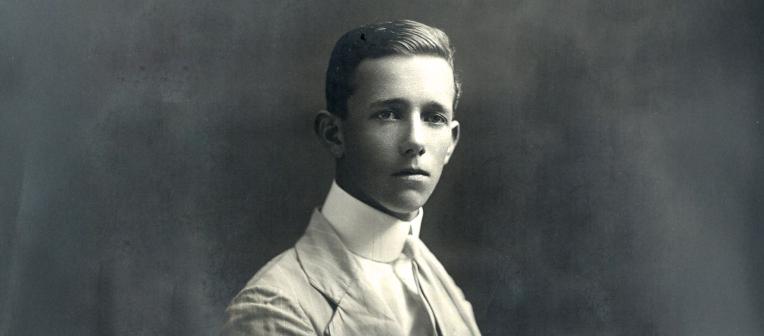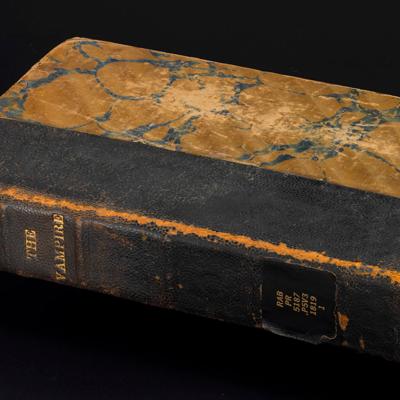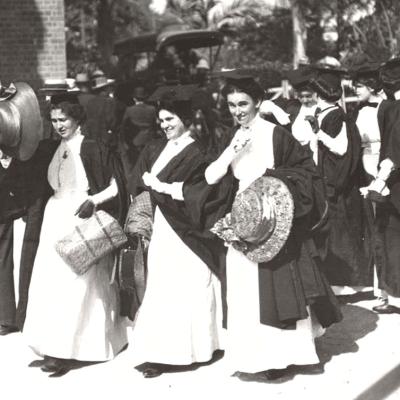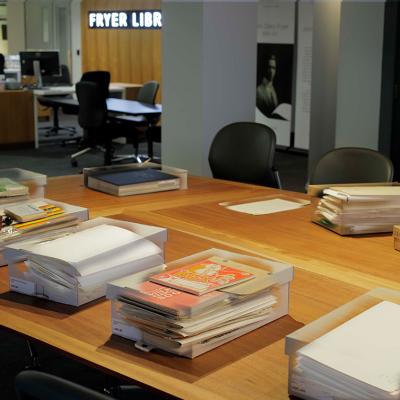The Fryer Library as we know it today owes its existence to former UQ student, John Denis (Jack) Fryer. Two other key players in the library's growth were UQ academic, Dr Frederick Walter Robinson, and Father Edward Leo Hayes.
The student: John Denis Fryer
John Denis (Jack) Fryer was born in 1895 in Springsure, Central Queensland. He attended Rockhampton Grammar School and in 1915 he won a scholarship to The University of Queensland (UQ).
Soon after starting his first term at UQ, Jack volunteered for military service in the Australian Imperial Force. He was commissioned in 1916 and served in France and Belgium in 1917. In August 1918 he was badly wounded in a German attack. Jack returned home in July 1919 and started University again in March 1920. He resumed his studies with commitment and enthusiasm and was working towards achieving a Classic Honours degree. A popular and active figure on campus, Jack was also editor of the student magazine, Galmahra, Vice-President of the Dramatic Society and a representative rugby player.
By mid-1922, Jack had developed tuberculosis. Too sick to sit for his final honours examinations, he returned home to Springsure and died in February 1923. The University Senate had awarded Jack his Bachelor of Arts degree on 15 December 1922.
As a memorial to their former member and vice-president, members of the University Dramatic Society donated £10 to establish a collection of works in Australian literature. This collection was the foundation for the Fryer Memorial Library of Australian Literature, established in 1927.
The John Denis Fryer Papers
The John Denis Fryer Papers (UQFL23) feature items from Jack's life. They reveal a loving son and brother and a devoted student and soldier. Items include photographs of Fryer with his family and from his student days at The University of Queensland, letters and cards sent home to Springsure from the battlefields of France, military maps of Amiens and St Quentin, and his medals. A selection of Fryer’s photographs and correspondence is also available online. The obituaries in the collection, written following Fryer's death, show the high regard in which he was held.
Find out more
Our online exhibition features correspondence and photographs from Fryer's life, including his time as a student at The University of Queensland and his service in the First World War.
The academic: Dr Frederick Walter Robinson
Australian literature was still a relatively new academic field at The University of Queensland in 1927 but creating a library dedicated to the subject became a passion project for one academic.
Dr Frederick Walter Robinson – known affectionately by students as Doc Robbie – was born in Sydney in 1888. He was an academically gifted child and won several scholarships that allowed him to complete his education at Sydney Boys' High School, University of Sydney and the University of Jena in Germany.
After serving in World War I, first in the Field Ambulance and later as an intelligence officer, Robinson returned to Australia. In 1923, he moved to Brisbane to become a lecturer in English and German at The University of Queensland. He was highly involved in the design of the St Lucia campus and many of his plans for how he felt the University site should look are now held in the Fryer Library.
Robinson's association with the military continued throughout his career. He worked in intelligence again during World War II and was instrumental in coordinating The University of Queensland's contribution to the war.
Robinson and the Fryer Library
The Fryer Library began as a collection of books in a single cabinet in Robinson's office. As a lecturer in the English Department, Robinson became the champion of the Fryer Library, petitioning the University for funds to buy more books and designing the new space for the library when the department moved to St Lucia from George Street in the 1950s. He even had bookcases and a display cabinet made to his specifications for the library. The cabinet can be seen inside the entrance from the Great Court to Duhig Tower.
The Reading Room at that time was adjacent to Robinson's office. In addition to his academic work, Robinson acted as the Fryer librarian, selecting books for acquisition and helping students with their enquiries. Robinson continued to make time for the Fryer Library after he was appointed as a professor, and he remained a keen advocate when the library moved from the English Department to the University of Queensland Library.
The Frederick Walter Robinson Reading Room (FW Robinson Reading Room) in the Fryer Library is named after him.
Find out more
The Frederick Walter Robinson Papers (UQFL5) contains material relating to Robinson's career as an academic. It includes lectures, research notes and early records about the Fryer Library. View digitised materials from the collection in UQ eSpace.
The priest: Father Edward Leo Hayes
Father Edward Leo Hayes (1889–1967) was a Catholic priest who lived in Oakey, Queensland. He was an inveterate and eclectic book collector. His books filled the house and the presbytery and were interspersed with collections of other objects.
A pre-eminent private collection
The Hayes Collection was acknowledged worldwide as one of the great Australian collections and the pre-eminent private collection accumulated in the 20th century. With limited resources, but with a multitude of generous friends and very patient booksellers, Father Hayes amassed an extraordinary collection.
Among the manuscripts in his possession were letters and poems from well-known figures including Dame Mary Gilmore, Paul Grano, Steele Rudd, Henry Lawson, William Morris, Miles Franklin, A.B. Paterson and A. G. Stevens.
Father Hayes was proud of his book collection, which included a first edition of Matthew Flinders’ A Voyage to Terra Australis, and Gregory Mathews’ Birds of Australia, as well as limited editions and sometimes sole surviving copies of fiction, essays and poetry of many Australian authors.
At the time of his death, Father Hayes' collection exceeded 100,000 items including:
- 25,000 books – 19,000 of these were on Australian subjects
- 30,000 manuscript items
- more than 4000 geological specimens
- 1500 anthropological artefacts.
Many of the books and manuscripts came to the Fryer Library.
The Hayes Collection is a monument to one man’s love of literature and the world around him.
The University of Queensland acquired the remarkable Father Edward Leo Hayes Collection in 1967. It took four trucks to move the Hayes Collection to UQ. Each carried 80 crates containing 400 cartons. The collection doubled the University’s resources to support Australian subjects and the Fryer Library became the premier institution for higher research in Australian studies. The collection has provided material for outstanding research and contributed to the reputation of the Fryer Library as a pre-eminent research collection. A special issue of Fryer Folios was dedicated to the collection to mark its 40th anniversary in 2007.
Our noblest collection, and a great source of pride, is the Father Leo Hayes collection. This was the work of a lifetime and the work of a devoted Australian patriot. Its treasures are detailed in the University Library’s Brochure in his memory. There is no scholar working in the Robinson Room who does not surround himself equally with Fryer and Hayes material. One supplements the other to an amazing degree.
Source: The Fryer Memorial Library of Australian Literature. [St. Lucia, Queensland] [Fryer Memorial Library, University of Queensland]





